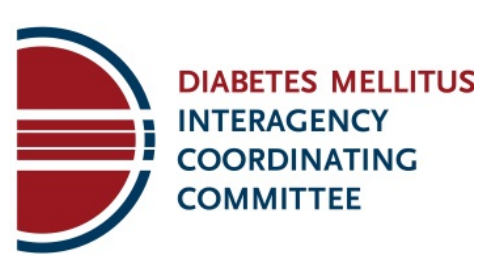Diabetes Mellitus Interagency Coordinating Committee (DMICC)
Background

Originally mandated by Public Law 93-354 and established in 1974, the Diabetes Mellitus Interagency Coordinating Committee (DMICC) is chaired by the National Institute of Diabetes and Digestive and Kidney Diseases (NIDDK) and includes other members of the Department of Health and Human Services and other federal agencies that support diabetes-related activities. The DMICC facilitates cooperation, communication, and collaboration on diabetes among these government entities. DMICC meetings, held several times a year, help members identify emerging issues and opportunities and develop ways in which different government components can work together and build upon each other’s expertise and resources. This approach helps ensure that federal diabetes activities are coordinated and not duplicated, as well as stimulates collaborations where appropriate.
- Who Are the DMICC Members?
- How Does the DMICC Coordinate Diabetes Activities Across the Government?
- What Diabetes Activities Have Been Successfully Coordinated Across the Government?
- What Are the Next Steps for the DMICC?
- Contact the DMICC
Who Are the DMICC Members?
The DMICC currently includes representatives from:
DHHS Agencies
- Department of Health and Human Services (DHHS)
- Agency for Healthcare Research and Quality (AHRQ)
- Centers for Disease Control and Prevention (CDC)
- Centers for Medicare and Medicaid Services (CMS)
- Health Resources and Services Administration (HRSA)
- Food and Drug Administration (FDA)
- Indian Health Service (IHS)
- Office of Minority Health (OMH)
Non-DHHS agencies
Member agencies represent a spectrum of diabetes activities across the government, contributing at various stages to fostering research and to a paradigm of translating the results of diabetes biomedical and behavioral research from the bench to the bedside to the community.
How Does the DMICC Coordinate Diabetes Activities Across the Government?
Through Meetings: DMICC meetings provide in-depth information from the various programs and from experts outside the government on diabetes and its complications; help to catalyze new projects; and coordinate projects involving several agencies.
Through Strategic Planning: The DMICC also plays a key role with respect to strategic planning for diabetes research. For example, Advances and Emerging Opportunities in Diabetes Research: A Strategic Planning Report of the DMICC (February 2011) was developed under the auspices of the DMICC with broad external input. Many ongoing clinical studies are collaborative efforts involving multiple NIH Institutes and Centers and other government components, and coordination through DMICC was important for research planning efforts.
Through Development and Coordination of Special Programs: For example, the DMICC plays an important role in providing input on diabetes research supported by the trans-HHS Special Statutory Funding Program for Type 1 Diabetes Research. This special program is led by the NIDDK and involves numerous Institutes and Centers of the NIH, as well as the CDC.
Through Evaluation of Ongoing Diabetes Efforts: The DMICC has coordinated efforts to assess the status of federally-supported research efforts on diabetes and its complications. For example, DMICC members provided input on a December 2010 congressionally-mandated evaluation report of the Special Statutory Funding Program for Type 1 Diabetes Research demonstrating its success in advancing diabetes research.
What Diabetes Activities Have Been Successfully Coordinated Across the Government?
Examples Include:
- Preventing or delaying type 2 diabetes through the Diabetes Prevention Program (DPP), and translating and disseminating the positive results of this clinical trial as public health messages via diabetes prevention awareness campaigns targeting high risk populations.
- Addressing diabetes in communities at risk around the U.S., through programs such as Diabetes Education in Tribal School and the statutory Special Diabetes Program for Indians, and through educational campaigns addressing populations disproportionately affected by diabetes.
- Ensuring consistent information about diabetes for the public through a process in which components of DHHS, voluntary groups, professional organizations, and others develop and share statistics for diabetes and pre-diabetes in the U.S.
- Partnering on research and regulatory issues for the “artificial pancreas" and for development of guidance for diabetes therapeutics development through an interagency working group, public workshops, and other efforts.
- Partnering on surveillance efforts for diabetes prevalence, incidence, and control, as well as on studies to identify effective practices and barriers to improved care in managed care and other health care delivery settings.
- Collaborating on the design of studies on islet transplantation as a novel therapy for type 1 diabetes.
- Developing research initiatives and activities to address specific problems such as foot ulcers, the emergence of type 2 diabetes in children, and metabolic complications of atypical psychotropic drugs following DMICC meetings targeting these specific issues.
What Are the Next Steps for the DMICC?
The DMICC continues to improve the dissemination of information about diabetes and enhance coordination of federal efforts to advance diabetes research and improve the health of Americans with or at risk for diabetes. Future meetings will focus on new opportunities for collaboration, forging new partnerships, and strategic planning to ensure effective deployment of federal resources to better understand, prevent, and treat diabetes in the U.S.
Contact the DMICC
If you have questions about the DMICC or would like to be added to the listserv to be notified of future DMICC meetings, please email DMICC@mail.nih.gov.
